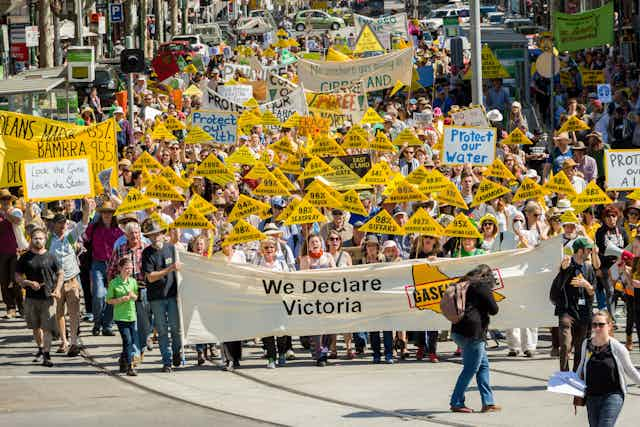The Victorian government has announced it will permanently ban unconventional gas, often produced through the controversial process of hydraulic fracturing or “fracking”. Legislation to implement the ban will be introduced this year.
This ban follows a 2015 report on unconventional gas. Following extensive review, committee members were split over whether to implement a full ban or extend the moratorium on onshore gas development by five years.
The ban announced by the government won’t apply to offshore gas. The government will also legislate to extend a moratorium on onshore conventional gas until 2020. Any future decision to approve onshore conventional gas exploration and production will be subject to review by an expert panel.
So will the ban make a difference?
Where did the ban come from?
The moratorium has been in place since 2012. It applies to all types of onshore gas (tight, shale, coal seam and conventional gas) and to any approval for fracking, exploration drilling activities and the use of chemicals us in fracking.
Last year the Victorian government examined the ban and consulted farmers and other landholders, environment and community groups, the gas industry, gas market analysts, hydrogeologists, manufacturers, tourism operators, local governments and the general public.
The final report was the product of more than 1,600 submissions over a six-month period, as well as the findings of the Victorian Auditor-General Report on Unconventional Gas.
The rationale for the ban comes from two core factors. The first is the significant degree of community concern about the social and environmental impacts of onshore unconventional gas, particularly those associated with hydraulic fracturing.
Secondly, the future economic benefits connected with unconventional gas development did not appear, from the findings of the reports, to outweigh those risks. Indeed, the final report found that it was unlikely that strong unconventional gas reserves were present in large commercial and extractable qualities in Victoria’s brown coal fields.
On the other hand, any development would be highly likely to have a dramatic effect on the region’s agriculture and tourism sectors.
Can fracking be permanently banned?
The existing regulatory framework does not recognise any ban on onshore unconventional gas. Indeed, the provisions in the Mineral Resources Sustainable Development Act explicitly include exploration and mining licences for coal seam gas projects.
However, these regulatory frameworks are being completely overhauled. It is clear that the new provisions will introduce a permanent prohibition on unconventional exploration and development in Victoria. The scope and nature of the ban will depend upon the wording of these provisions.
Any law that is introduced cannot be overridden at the national level because the ownership and management of all onshore minerals and hydrocarbons, including gas, are vested in the state.
Pros and cons
The ban will end the strong environmental concerns that continue to exist around unconventional gas production. It will also alleviate some of the emerging conflicts over land allocation and water usage that have emerged between regional food, tourism and energy sectors.
The ban will also ease climate concerns connected with the generation of energy from fossil fuels. In Australia, fugitive emissions from coal mining, oil and gas production account for approximately 8% of Australia’s greenhouse gas emissions.
Gas extraction, whether conventional or unconventional, can result in significant methane seepage. To date, very few baseline studies are available to compare seepage from drilling and fracking with natural methane seepage.
The ban is likely, however, to have a negative impact on supply, which may affect domestic gas pricing. This is particularly the case if the moratorium on onshore conventional gas production continues and no policy is implemented requiring gas producers to reserve a percentage of produced gas for domestic usage.
The 2015 Gas Market Report, released in March this year, showed that the nexus between international gas prices and east coast LNG production for export, domestic demand and domestic gas prices has become increasingly complex.
Theoretically, eastern Australia has enough reserves to supply the domestic and export markets for the next 20 years. But if the market is divided into the north (Queensland and Cooper Basin) and the south (Victoria and New South Wales) there is unlikely to be enough reserves in the south to meet forecast demand, particularly following the ban.
This will inevitably require the development of more gas reserves in other areas of the south, or imports from the north. If international gas prices and demand support more east coast LNG production, things will get worse as this supply will not be available in the north.
Victoria will, however, continue to utilise gas exploration and production in offshore gas wells in Bass Strait. There are 23 offshore platforms in the strait and ExxonMobil has held these titles for many years.
The offshore gas wells have traditionally supplied most of Victoria’s domestic gas market. Consequently, if the ban did apply to offshore gas exploration and production, it would have a profound effect on domestic gas supply.
Such a ban is, however, unlikely. First, it could not apply to offshore wells located beyond the territorial sea because these come under Commonwealth jurisdiction.
Second, a ban could not be applied retrospectively. Hence it would not affect established offshore title holders who have been supplying the domestic gas market for many years.

